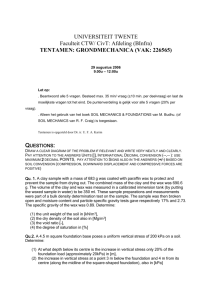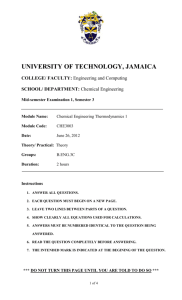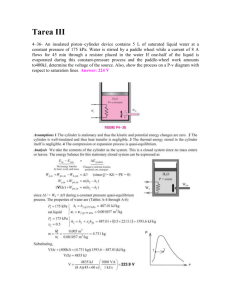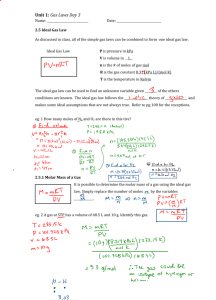CE 462/562 Foundation Engineering I Typical questions of Exam 1
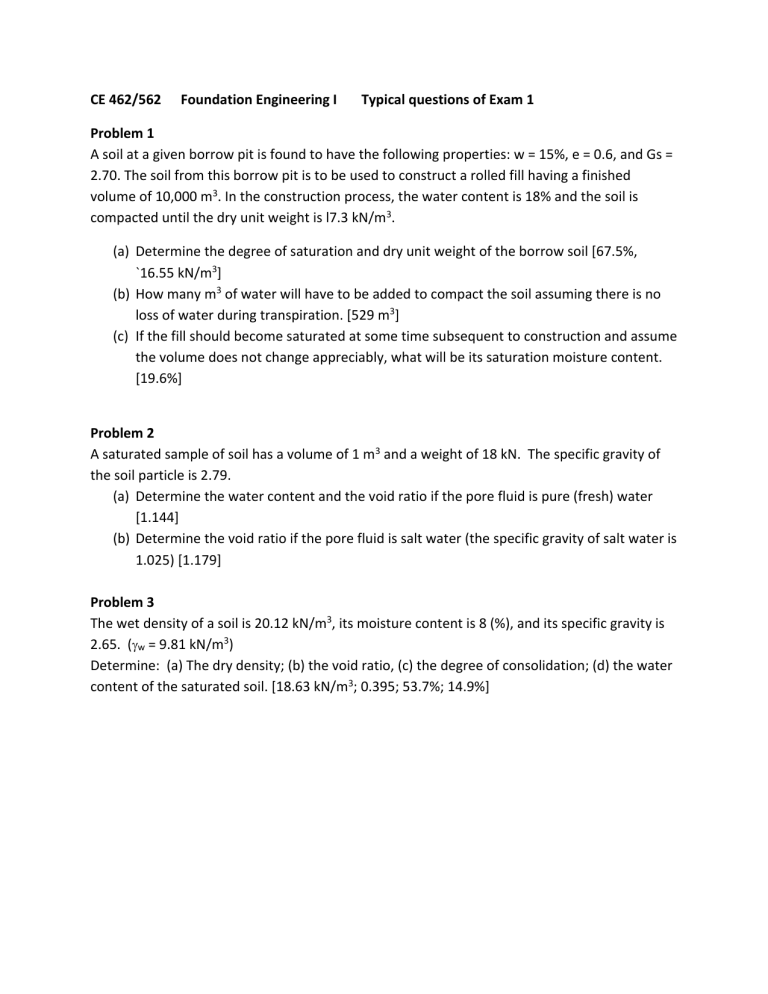
CE 462/562 Foundation Engineering I Typical questions of Exam 1
Problem 1
A soil at a given borrow pit is found to have the following properties: w = 15%, e = 0.6, and Gs =
2.70. The soil from this borrow pit is to be used to construct a rolled fill having a finished volume of 10,000 m 3 . In the construction process, the water content is 18% and the soil is compacted until the dry unit weight is l7.3 kN/m 3 .
(a) Determine the degree of saturation and dry unit weight of the borrow soil [67.5%,
`16.55 kN/m 3 ]
(b) How many m 3 of water will have to be added to compact the soil assuming there is no loss of water during transpiration. [529 m 3 ]
(c) If the fill should become saturated at some time subsequent to construction and assume the volume does not change appreciably, what will be its saturation moisture content.
[19.6%]
Problem 2
A saturated sample of soil has a volume of 1 m 3 and a weight of 18 kN. The specific gravity of the soil particle is 2.79.
(a) Determine the water content and the void ratio if the pore fluid is pure (fresh) water
[1.144]
(b) Determine the void ratio if the pore fluid is salt water (the specific gravity of salt water is
1.025) [1.179]
Problem 3
The wet density of a soil is 20.12 kN/m 3 , its moisture content is 8 (%), and its specific gravity is
2.65. ( w
= 9.81 kN/m 3 )
Determine: (a) The dry density; (b) the void ratio, (c) the degree of consolidation; (d) the water content of the saturated soil. [18.63 kN/m 3 ; 0.395; 53.7%; 14.9%]
Problem 4
The results of two CD tests on 38‐mm diameter and 76‐mm long samples of a soil at failure are as follows:
Test number
1
’c (KPa) confining pressure
100
Deviator stress (kPa)
247.8
2 180
(a) Determine the friction angle of this soil [24.6
]
(b) If the soil is sand, what is the friction angle [33.6
]
362.0
(c) Discuss the result base on the strength parameters determined from (a) and (b)
Problem 5
Consolidated triaxial compression tests have been run on specimens from a large sample of clay. In tests 1 to 3, the tests were run so slowly that complete drainage may be assumed.
In tests 3 and 4, no drainage was permitted.
1 2 3 4 Test No.
All‐round cell pressure (
3
)
89 kPa 36 kPa 131 kPa 53 kPa
Axial stress At failure (
1
)
256 kPa 131 kPa 264 kPa
Determine the effective and total strength parameters of the clay [15 kPa, 23.9
]
172 kPa
Problem 6
The following data are obtained from two consolidated‐undrained triaxial compression tests on identical specimens of a normally consolidated clay:
Condition
All‐round consolidation pressure
Test #1
50 kPa
Test #2
100 kPa
At failure
1
=75 kPa u = 25 kPa
1
=150 kPa u = 50 kPa e = 0.990 e = 0.880
(a) What will be the maximum stress difference at failure for a third specimen consolidated under an all‐round pressure of 200 kPa? [300 kPa]
(b) What will be the pore water pressure at failure? [100 kPa]
(c) Estimate the void ratio of the third specimen [0.77]





